OCZ RevoDrive 3 X2 (480GB) Preview: 200K IOPS & 1.5GB/s for $1699?
by Anand Lal Shimpi on June 28, 2011 12:00 PM EST- Posted in
- Storage
- SSDs
- SandForce
- OCZ
- RevoDrive
- SF-2000
- RevoDrive 3
- RevoDrive 3 X2
AnandTech Storage Bench 2011
Last year we introduced our AnandTech Storage Bench, a suite of benchmarks that took traces of real OS/application usage and played them back in a repeatable manner. I assembled the traces myself out of frustration with the majority of what we have today in terms of SSD benchmarks.
Although the AnandTech Storage Bench tests did a good job of characterizing SSD performance, they weren't stressful enough. All of the tests performed less than 10GB of reads/writes and typically involved only 4GB of writes specifically. That's not even enough exceed the spare area on most SSDs. Most canned SSD benchmarks don't even come close to writing a single gigabyte of data, but that doesn't mean that simply writing 4GB is acceptable.
Originally I kept the benchmarks short enough that they wouldn't be a burden to run (~30 minutes) but long enough that they were representative of what a power user might do with their system.
Not too long ago I tweeted that I had created what I referred to as the Mother of All SSD Benchmarks (MOASB). Rather than only writing 4GB of data to the drive, this benchmark writes 106.32GB. It's the load you'd put on a drive after nearly two weeks of constant usage. And it takes a *long* time to run.
1) The MOASB, officially called AnandTech Storage Bench 2011 - Heavy Workload, mainly focuses on the times when your I/O activity is the highest. There is a lot of downloading and application installing that happens during the course of this test. My thinking was that it's during application installs, file copies, downloading and multitasking with all of this that you can really notice performance differences between drives.
2) I tried to cover as many bases as possible with the software I incorporated into this test. There's a lot of photo editing in Photoshop, HTML editing in Dreamweaver, web browsing, game playing/level loading (Starcraft II & WoW are both a part of the test) as well as general use stuff (application installing, virus scanning). I included a large amount of email downloading, document creation and editing as well. To top it all off I even use Visual Studio 2008 to build Chromium during the test.
The test has 2,168,893 read operations and 1,783,447 write operations. The IO breakdown is as follows:
| AnandTech Storage Bench 2011 - Heavy Workload IO Breakdown | ||||
| IO Size | % of Total | |||
| 4KB | 28% | |||
| 16KB | 10% | |||
| 32KB | 10% | |||
| 64KB | 4% | |||
Only 42% of all operations are sequential, the rest range from pseudo to fully random (with most falling in the pseudo-random category). Average queue depth is 4.625 IOs, with 59% of operations taking place in an IO queue of 1.
Many of you have asked for a better way to really characterize performance. Simply looking at IOPS doesn't really say much. As a result I'm going to be presenting Storage Bench 2011 data in a slightly different way. We'll have performance represented as Average MB/s, with higher numbers being better. At the same time I'll be reporting how long the SSD was busy while running this test. These disk busy graphs will show you exactly how much time was shaved off by using a faster drive vs. a slower one during the course of this test. Finally, I will also break out performance into reads, writes and combined. The reason I do this is to help balance out the fact that this test is unusually write intensive, which can often hide the benefits of a drive with good read performance.
There's also a new light workload for 2011. This is a far more reasonable, typical every day use case benchmark. Lots of web browsing, photo editing (but with a greater focus on photo consumption), video playback as well as some application installs and gaming. This test isn't nearly as write intensive as the MOASB but it's still multiple times more write intensive than what we were running last year.
As always I don't believe that these two benchmarks alone are enough to characterize the performance of a drive, but hopefully along with the rest of our tests they will help provide a better idea.
The testbed for Storage Bench 2011 has changed as well. We're now using a Sandy Bridge platform with full 6Gbps support for these tests. All of the older tests are still run on our X58 platform.
AnandTech Storage Bench 2011 - Heavy Workload
We'll start out by looking at average data rate throughout our new heavy workload test:
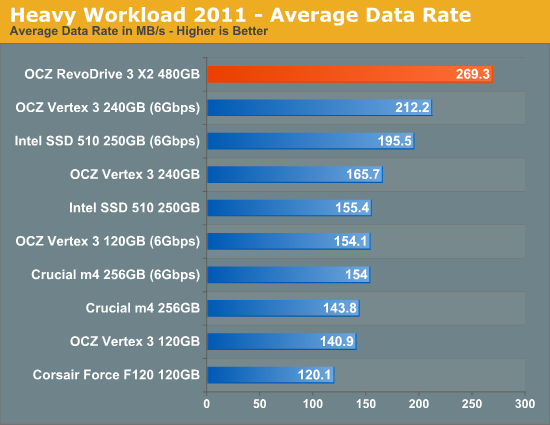
Average performance in our Heavy workload is improved over a single Vertex 3, but not tremendously. Where we really see a tremendous performance increase is when we look at the breakdown of reads/writes:
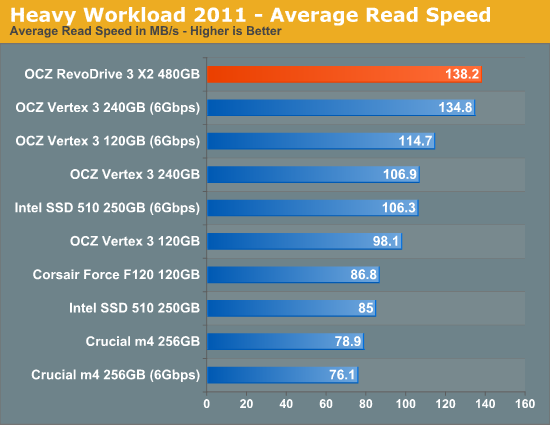

Write speed is much improved over a single 240GB Vertex 3. It's not quite the improvement you'd expect from a 4-controller configuration, but I'd expect that this is the sort of performance improvement most workstation users would see.
The next three charts just represent the same data, but in a different manner. Instead of looking at average data rate, we're looking at how long the disk was busy for during this entire test. Note that disk busy time excludes any and all idles, this is just how long the SSD was busy doing something:
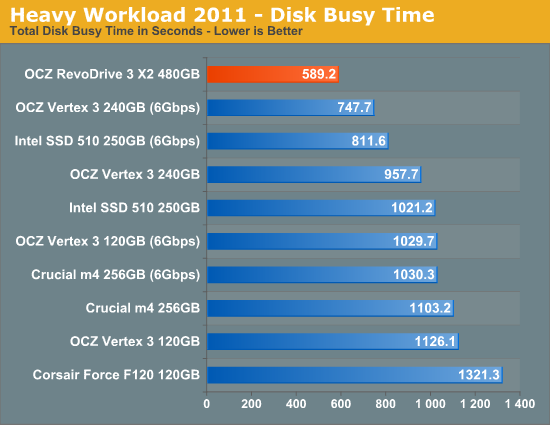
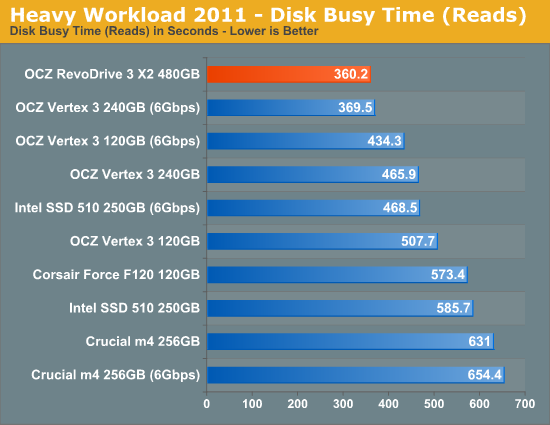
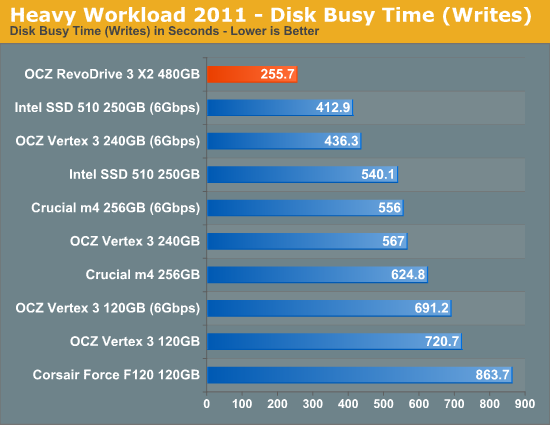










38 Comments
View All Comments
yuhong - Friday, July 1, 2011 - link
Vista changed driver signing a lot. It added a kind of driver signing that do not require WHQL certification that meets the minimum requirements for 64-bit Vista and later fo load the driver.bjacobson - Saturday, July 2, 2011 - link
I know desktop users are not the market segment for these drives, but I'd very much like to see these benched in a way that shows us just how much they can help productivity-- IE, I'd like to see how fast a Windows install with about 50-100 startup programs can boot with one of these, in comparison with a harddrive.not12quit - Friday, July 8, 2011 - link
I have never understood, nor used raid but I am really interested in this drive as I use a lot of high i/o intensive, large file manipulating software.My question is if the drive has a 240gb capacity, does raid mean that you can actually only store 60gb of real data? ei 240/4 raid disks.
thanks four your patience if this is a "dumb question"/
Hydrology - Tuesday, August 9, 2011 - link
I would like to see how reliable these things are. I am still trying to get my Vertex 3's to stay up for more than a day without locking up or giving me a BSOD. There are thousends of us out there that bought these drives and are still hanging in limbo as OCZ continues with their "firmware of the week" program to try and make these drives stable. Until they can get the Vetex 3's stable, I wouldnt touch another OCZ product with a 10 foot pole. The fast speed is only usefull if the drive is dependable, and OCZ drives are NOT!pchandra - Sunday, August 28, 2011 - link
Where would FPS games fall - Heavy workload or Incompressible data transfer?What would be the expected through puts for games like Crysis 2, Mass Effect 2, Call of Duty (Entire series) Medal of Honor etc.
Frichico - Sunday, February 19, 2012 - link
http://www.ebay.es/itm/120862274680?ssPageName=STR...nakabaka - Thursday, March 14, 2013 - link
I know this is an old forum but I'm having issues finding anything current on this drive, or at least after its release. I bought one and am playing games on it, granted all I play is WoW and EVE (I use it for a boot drive and use another SATA SSD as a storage drive). Said that Windows 7 64-bit can't boot from it, but for some reason I had no issue. Is that an indicator something is wrong or has it been fixed? (Probably a dumb question but just making sure.) Also, did they fix something about the TRIM support? I have fragmented drives because I thought it was supposed to be that way with TRIM and how it supposedly saves data to random spots to save cell lifetime (if I even understand it correctly), but if 7 64-bit doesn't support TRIM, does that mean I can defrag this thing for better performance?nakabaka - Thursday, March 14, 2013 - link
Also, sorry if that has already been answered, I've only been able to follow about half of this. Something about that it uses a SAS controller instead of a SATA controller to cut out more middle man kinda stuff with controller bridging (if I'm using correct terms) and that is what made it have so many issues.